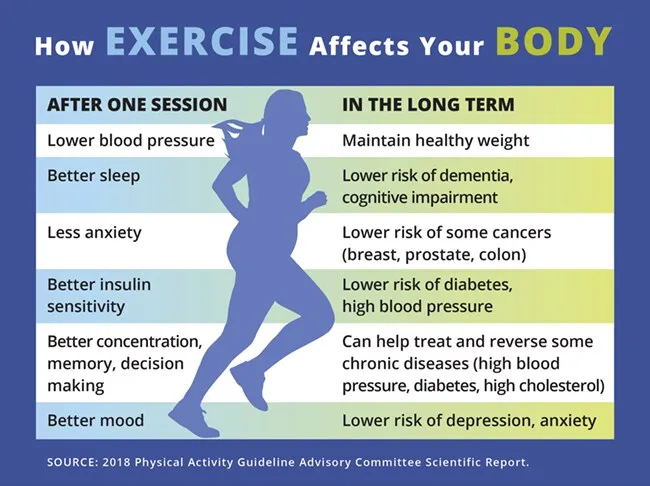The Exercise Prescription

Is Physical Activity the Best
Medical Treatment After All?
Lucas Carr is on a mission to improve the health of Iowans through exercise.
“There is no medicine in existence that has all the benefits of this one thing,” Carr said. The associate professor of Health and Human Physiology at the University of Iowa is chair of UI’s Exercise Is Medicine® (EIM) program.
Exercise as Medicine
First launched in 2007, EIM is a global health initiative designed to increase awareness about the health benefits of physical activity and integrate exercise into the healthcare system.
Primary care doctor Robert Sallis, MD, chairs the national Exercise Is Medicine initiative. He’s “underwhelmed” by the medical status quo, and he believes doctors can help many more of their patients by simply following this three-step protocol:
- Ask about exercise at every appointment.
- Treat physical activity as a vital sign and make a note of it.
- Prescribe exercise as a fundamental part of every treatment plan.

How the States
Stack Up
Insurance analysts at Quote Wizard recently rated all 50 states for physical activity levels based on the CDC’s Behavioral Risk Factor Surveillance System (BRFSS) data. Here’s what they found:
- Colorado, Utah, and Washington are the most physically active states.
- Alabama, Mississippi, and Arkansas are the least physically active states.
- Iowa was the 31st most physically active state.
- Twenty-four states showed a decline in physical activity over the last three years.
- Since 2020, physical activity increased the most in New Jersey and decreased the most in Maine.
Click here to view the complete rating list.
Specifics are important for Dr. Cate Collings, president of the American College of Lifestyle Medicine. She recommends that physicians provide patients with an exercise prescription that spells out precisely what to do, for how long, and how often. Practitioners must specifically tailor prescriptions to treat the patient's condition.
Locally, Professor Carr is working to ensure that Iowa healthcare providers are on board. He’s got his work cut out for him.
Why Doctors Don’t Prescribe Exercise
Recent studies revealed that American doctors recommend physical activity to only one-third of their patients with high blood pressure and 18% of those with diabetes.
Research published in the Medical Journal of Australia identified two key barriers to prescribing exercise:
- Lack of medical school training and
- The doctors’ own level of physical activity.
The first obstacle may finally be changing as medical schools and residency programs begin to include training on exercise and other healthy behaviors in their core curricula.
According to a recent Wall Street Journal article, the universities that now incorporate "lifestyle medicine" into their training programs include Brown, Harvard, Stanford, the University of Oklahoma, historically Black colleges and universities, and schools of osteopathic medicine.
Student interest groups are active at more than 100 U.S. campuses, and more than 200 residency programs include a lifestyle-medicine curriculum.
Walk With a Doc
But prescribing exercise does not guarantee the patient will follow through.
Cardiologist David Sabgir of Columbus, Ohio, was frustrated with his patients’ reluctance to take that first step. So in 2004, he started walking with them. A year later, he launched Walk With a Doc, a nonprofit organization that pairs patients with doctors for walks. Today WWAD has chapters in 34 countries and hosts 130,000 walks per year.
In addition to the exercise benefits, Sabgir credits the effort’s success to group bonding and spending time outdoors.
--Article Continues Below--

More Than Exercise Needed for Weight Loss
However, if the main reason for starting an exercise regimen is merely to lose weight, most patients will be disappointed.
Most studies indicate moderate aerobic exercise without a change in dietary habits typically produces little or no weight loss. In fact, to achieve any meaningful weight loss through exercise alone, study participants had to burn a minimum of 400 calories per session five or more days per week.
That correlates to 90 minutes per day of brisk walking -- or 30 minutes of running eight-minute miles -- for a 150-pound person. Exercisers who can achieve that level of physical activity are often dismayed to discover that their bodies compensate by boosting their appetite and dialing down their metabolism.

The Fountain
of Youth?
A new study published in the Journal of Physiology suggests that exercise may reverse the effects of aging by helping to reprogram cells. Researchers who analyzed genes within the muscle fibers of aged mice found evidence of cell rejuvenation following exercise.
“Exercise is the most powerful drug we have,” said Kevin Murach, assistant professor at the University of Arkansas and one of the study’s authors.
Of course, the benefits of physical activity extend well beyond weight loss. And while moderate exercise may not melt away the pounds, it can prevent weight gain and increase muscle mass.
How to Get Involved
If you’re a healthcare provider interested in helping your patients become more active, EIM provides resources to get you started:
- The EIM Summary Sheet offers a quick overview of Exercise is Medicine® and recommended physical activity guidelines.
- EIM's Health Care Providers' Action Guide is a step-by-step tool to help providers integrate physical activity into their medical practices.
- A series of patient handouts, Rx for Health, is tailored toward sedentary patients of all ages and those with various medical conditions.
Professor Carr hopes to get all Iowa care providers on board.
“A lot of times, it’s a matter of convincing hospital administrators that this is an important thing that we should be doing for every patient at every visit,” Carr said.
Sources:
Featured Image: Adobe, License Granted
University of Iowa
The Gazette
Medical Journal of Australia
Time
Journal of Physiology
Recent Posts











Share On: